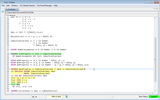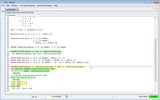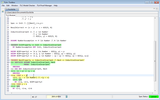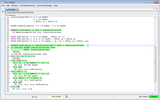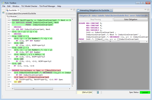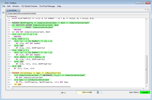Hierarchical proofs
Our proof requires the following properties of GCDs, which for
simplicity we just assume:
Known and usable facts
At any point in a TLA+ proof, there is a current obligation that
is to be proved. The obligation contains
a context of
known facts, definitions,
and declarations, and a goal.
The obligation claims that the goal is logically entailed by the
context. Some of the facts and definitions in the context are
marked as usable for
reasoning, while the remaining facts and definitions
are hidden. That obligation
is then sent to a backend
(Zenon,
Isabelle,
SMT solvers – see the tactics
section) that tries to prove it. The smaller the context is,
the faster those backends are. Hence TLAPS tries to keep that
context as small as possible. For example,
the axioms about GCD stated above are not
directly usable by the backends: they
are known
but not usable. As we have
seen in the simple proof
section, you have to explicitly USE
or cite a fact in order for it
to be included in the context of the obligation sent to backends.
As an exception to this rule,
domain facts of the form
x \in S are always usable in a proof. (Such assumptions are
typically introduced in an ASSUME … PROVE
construct, most frequently in the form of an assumption
NEW x \in X.)
Moreover, unnamed
proof steps (see below) are aways usable. The other known facts
are hidden by default.
Let us get back to our example. Now that
we have proved that the initial state satisfies the invariant, let
us prove that this invariant is preserved by the next-state
relation Next
SUFFICES
Let us first simplify the goal to be proved by using
a SUFFICES construct:
This step asserts that it is sufficient to
prove InductiveInvariant' while
assuming InductiveInvariant and Next.
Because the step is unnamed,
both facts InductiveInvariant
and Next are also made usable for the remainder of the
proof. For more information about SUFFICES, see
the section about other proof
constructs.
USE
We'll need the definitions of InductiveInvariant
and Next to be usable in the entire body of the
proof. Hence, rather than making them usable with
a BY DEF construct in each
step, we can make them usable for all proof steps by using
the USE DEF construct once,
at the beginning of the proof:
The general form of a USE step is:
USE e1, …, em DEF d1, …, dn
which asserts that the definitions d1,
… dn are to be made usable, and the
facts e1, …, em are
to be checked and then added to the context as usable. When checking
these facts, all other known facts are temporarily considered to be
usable, so it is possible to say USE e /\ f
when e and f are in the context but
hidden. Observe that the USE
directive is syntactically similar to BY,
but it obviously does not check if the current assertion
follows from the cited facts.
The QED step
To prove the theorem NextProperty, we have to reason by cases,
and prove that InductiveInvariant' is true when one of
the actions of Next is performed (i.e. when x
< y and also when x > y). Let us write
this outer level of the hierarchical proof:
<1>1, <1>a, <1>b
and <1>2 are step names
(the <1> part of the step name indicates the
step's level, which is 1. The proof itself consists of
four claims named by these step names (plus the two first unnamed
steps); the first three are unjustified, while the last is
justified by the cited
facts <1>1, <1>a
and <1>b. The QED
step asserts the main goal of the theorem. Let us verify that it
can be proved from
steps <1>1, <1>a
and <1>b:
After having asked TLAPS to prove the theorem,
the QED step gets colored
green. This means that facts mentioned by
steps <1>1, <1>a
and <1>b are sufficient to prove the theorem. But
as you can see, those proof steps are colored yellow, which means
that their proofs are omitted. (The Toolbox allows you to change
what colors are used to indicate the proof status of a step, and
also what proof statuses are displayed.) Let us now prove these
proof steps.
Non-QED steps
First, the proofs of
the SUFFICES step and
step <1>1 are obvious as you can see in the
following screenshot. In particular, step <1>1
follows from the usable fact Next introduced in
the unnamed SUFFICES step
and the definition of Next, which is also usable.
Let us now prove step <1>a. We subdivide this proof
into two steps of level 2. The first step asserts that
y - x \in Number and that y
is not less than x. The second,
QED step proves
the main goal from the case assumption of step <1>a,
the just established step <2>1, and axiom
GCDProperty3.
Let us now prove
step <2>1. We have to use
the case assumption <1>a and make
the definition of Number usable:
The proof of the y < x case is quite similar:
Then theorem NextProperty is proved by TLAPS:
Wrapping up the proof
Now we have InitProperty
and NextProperty, we can prove the main theorem.
First we prove that a stuttering step (i.e. a step that leaves
all variables unchanged) keeps the invariant unchanged. This is
proved simply by checking that the definition
of InductiveInvariant involves no
variables other than x and y:
Then we can prove that any process that follows the specification
must keep InductiveInvariant true at all times, by
using the previous step and the InitProperty
and NextProperty theorems:
Unfortunately, that doesn't work:
Indeed, none of the default back-end provers (SMT, Zenon, and
Isabelle) can deal with temporal logic. But TLAPS includes an
interface to a propositional temporal logic prover (LS4), which
can be invoked by adding PTL to the set of usable facts.
Since PTL is defined in the TLAPS.tla
standard module, we have to explicitly extend the TLAPS module:
Then we can use the PTL backend to prove
step <1>2:
Finally we prove that, at any point in time, our invariant
entails the correctness of the result, then use that to prove the
main theorem:
And this concludes the proof of correctness of Euclid's algorithm.
Summary
This is the whole file, with the specification and proofs:
